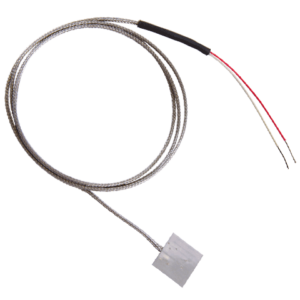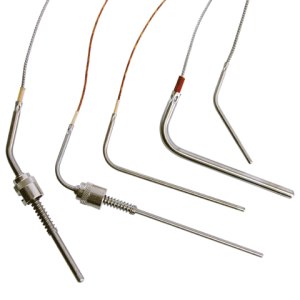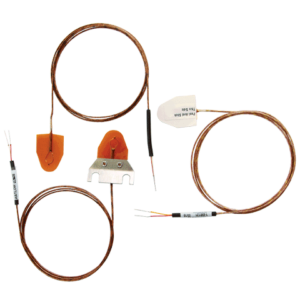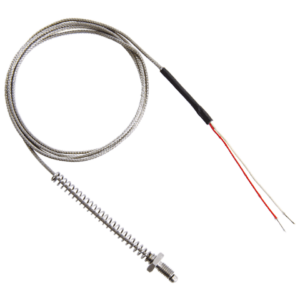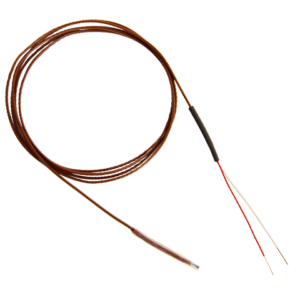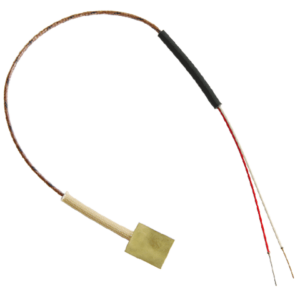-
STAINLESS STEEL SHIM TUBE & WIRE THERMOCOUPLES – STYLE 75
STAINLESS STEEL SHIM TUBE & WIRE THERMOCOUPLES – STYLE 75
THE SHIM STOCK THERMOCOUPLE HAS A LOW PROFILE AND CAN BE PLACED BETWEEN COMPONENTS FOR SURFACE TEMPERATURE MEASUREMENT
-
RING TERMINAL TUBE & WIRE THERMOCOUPLES – STYLE 70
RING TERMINAL TUBE & WIRE THERMOCOUPLES – STYLE 70
THE NICKEL TERMINAL CAN BE PLACED BENEATH EXISTING SCREWS OR BOLTS TO PERMIT SURFACE TEMPERATURE MEASUREMENT
-
RIGID SHEATH THERMOCOUPLES – STYLES 21, 22, 31, 32, 41 & 42
45° OR 90 ° BENDS FOR PLAIN SHEATH, SINGLE SLOT (STANDARD CAP) WITH SPRING, & LARGE DIAMETER SHEATH
The rigid sheath provides protection and accurate placement through bulkheads or platens. Use with a compression fitting for water tight immersion application.
The bent rigid tube offers protection and accurate lead placement around machinery.
-
RIGID SHEATH THERMOCOUPLES – STYLES 20, 23, 24, 25, 30, & 40
PLAIN, STRAIGHT SHEATH – NATIONAL PIPE THREAD (NPT) SS FITTING – FLANGE – SINGLE SLOT (STANDARD CAP) STRAIGHT – LARGE DIAMETER PLAIN, STRAIGHT SHEATH
The rigid sheath provides protection and accurate placement through bulkheads or platens. Use with a compression fitting for water tight immersion application.
Rigid sheath with threaded fitting provides accurate placement in process applications.
The flanged thermocouple allows rapid assembly and low profile when going through bulkheads.
-
POLYIMIDE BRACKET TUBE & WIRE THERMOCOUPLE
DESIGNED TO MEASURE ROLLER TEMPERATURE
The Polyimide thermocouple, when used with the aluminum bracket, is designed primarily to measure roller temperature. Light pressure on the roller enables the Polyimide thermocouple to measure roller surface temperature without using slip rings. This type of set-up greatly reduces lag time and eliminates slip rings cost and maintenance. It can also be used to measure conveyor belt temperatures and any other moving part by riding gently on the part surface.
-
PIPE CLAMP MOUNT TUBE & WIRE THERMOCOUPLES – STYLE 72
PIPE CLAMP MOUNT TUBE & WIRE THERMOCOUPLES – STYLE 72
THE STAINLESS STEEL CLAMP ALLOWS TEMPERATURE MEASUREMENT WITHOUT DRILLING OR TAPPING WHICH IS IDEAL FOR MEASURING PIPE TEMPERATURES
-
NOZZLE STYLE TUBE & WIRE THERMOCOUPLE – STYLE 71
NOZZLE STYLE TUBE & WIRE THERMOCOUPLE – STYLE 71
THE NOZZLE THERMOCOUPLE HAS A SHORT INSTALLATION DEPTH AND A LOW PROFILE TO ALLOW CONTROL OF THIN PLATEN SECTIONS
-
INSULATED TUBE & WIRE THERMOCOUPLES STYLE 62
SERV-RITE® INSULATED TUBE & WIRE THERMOCOUPLES – STYLE 62
STYLE 62 IS FITTED WITH AN ENCAPSULATED MEASURING JUNCTION THAT IS IDEAL FOR CORROSIVE FLUIDS AND GASES, SUCH AS SULFURIC ACID, HYDROFLUORIC ACID, STRONG MINERAL ACIDS AND OILS
-
INSULATED TUBE & WIRE THERMOCOUPLES STYLE 61
SERV-RITE® INSULATED TUBE & WIRE THERMOCOUPLES – STYLE 61
STYLE 61 IS FITTED WITH AN EXPOSED JUNCTION AND IS SUITABLE FOR MOST GENERAL PURPOSE APPLICATIONS, SUCH AS MEASURING AIR, GAS AND SURFACE TEMPERATURES.
Thermocouples feature flexible SERV-RITE® wire insulated with woven fiberglass or high temperature engineered resins. For added protection against abrasion, products can be provided with stainless steel wire braid and flexible armor. ASTM E230 color-coding identifies standard catalog thermocouple types.
The addition of a metal sheath over the thermocouple provides rigidity for accurate placement and added protection of the sensing junction.
-
GROMMET STYLE TUBE & WIRE THERMOCOUPLES – STYLE 73
GROMMET STYLE TUBE & WIRE THERMOCOUPLES – STYLE 73
THE EXTREMELY LOW PROFILE OF THE STAINLESS STEEL GROMMET PROVIDES FAST RESPONSE TIME
-
ENCAPSULATED TUBE & WIRE THERMOCOUPLES
PERFLUOROALKOXY (PFA) ENCAPSULATED TUBE & WIRE THERMOCOUPLES – STYLE 65
THE RIGID SHEATH IS COVERED WITH A 0.010 IN. (0.25 MM) WALL OF PFA FOR CORROSION RESISTANCE IN ACID ENVIRONMENTS
An epoxy seal improves moisture resistance of the sensor and provides a barrier for migrating fumes in corrosive applications.
-
BRASS SHIM TUBE & WIRE THERMOCOUPLES – STYLE 74
BRASS SHIM TUBE & WIRE THERMOCOUPLES – STYLE 74
THE SHIM STOCK THERMOCOUPLE HAS A LOW PROFILE AND CAN BE PLACED BETWEEN COMPONENTS FOR SURFACE TEMPERATURE MEASUREMENT

